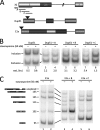Protein kinase C-dependent control of Bcl-x alternative splicing
- PMID: 17923691
- PMCID: PMC2169420
- DOI: 10.1128/MCB.00565-07
Protein kinase C-dependent control of Bcl-x alternative splicing
Abstract
The alternative splicing of Bcl-x generates the proapoptotic Bcl-x(S) protein and the antiapoptotic isoform Bcl-x(L). Bcl-x splicing is coupled to signal transduction, since ceramide, hormones, and growth factors alter the ratio of the Bcl-x isoforms in different cell lines. Here we report that the protein kinase C (PKC) inhibitor and apoptotic inducer staurosporine switches the production of Bcl-x towards the x(S) mRNA isoform in 293 cells. The increase in Bcl-x(S) elicited by staurosporine likely involves signaling events that affect splicing decisions, because it requires active transcription and no new protein synthesis and is independent of caspase activation. Moreover, the increase in Bcl-x(S) is reproduced with more specific inhibitors of PKC. Alternative splicing of the receptor tyrosine kinase gene Axl is similarly affected by staurosporine in 293 cells. In contrast to the case for 293 cells, PKC inhibitors do not influence the alternative splicing of Bcl-x and Axl in cancer cell lines, suggesting that these cells have sustained alterations that uncouple splicing decisions from PKC-dependent signaling. Using minigenes, we show that an exonic region located upstream of the Bcl-x(S) 5' splice site is important to mediate the staurosporine shift in Bcl-x splicing. When transplanted to other alternative splicing units, portions of this region confer splicing modulation and responsiveness to staurosporine, suggesting the existence of factors that couple splicing decisions with PKC signaling.
Figures






Similar articles
-
The Proto-oncogene PKCι regulates the alternative splicing of Bcl-x pre-mRNA.Mol Cancer Res. 2012 May;10(5):660-9. doi: 10.1158/1541-7786.MCR-11-0363. Epub 2012 Apr 20. Mol Cancer Res. 2012. PMID: 22522453 Free PMC article.
-
The DNA damage response pathway regulates the alternative splicing of the apoptotic mediator Bcl-x.J Biol Chem. 2011 Jan 7;286(1):331-40. doi: 10.1074/jbc.M110.162644. Epub 2010 Oct 27. J Biol Chem. 2011. PMID: 20980256 Free PMC article.
-
Bcl-x pre-mRNA splicing regulates brain injury after neonatal hypoxia-ischemia.J Neurosci. 2012 Sep 26;32(39):13587-96. doi: 10.1523/JNEUROSCI.2617-12.2012. J Neurosci. 2012. PMID: 23015448 Free PMC article.
-
Aberrant Bcl-x splicing in cancer: from molecular mechanism to therapeutic modulation.J Exp Clin Cancer Res. 2021 Jun 12;40(1):194. doi: 10.1186/s13046-021-02001-w. J Exp Clin Cancer Res. 2021. PMID: 34118966 Free PMC article. Review.
-
My road to alternative splicing control: from simple paths to loops and interconnections.Biochem Cell Biol. 2015 Jun;93(3):171-9. doi: 10.1139/bcb-2014-0161. Epub 2015 Feb 12. Biochem Cell Biol. 2015. PMID: 25759250 Review.
Cited by
-
Computational Methods for Predicting Functions at the mRNA Isoform Level.Int J Mol Sci. 2020 Aug 8;21(16):5686. doi: 10.3390/ijms21165686. Int J Mol Sci. 2020. PMID: 32784445 Free PMC article. Review.
-
Insulin promotes neuronal survival via the alternatively spliced protein kinase CδII isoform.J Biol Chem. 2012 Mar 16;287(12):9299-310. doi: 10.1074/jbc.M111.313080. Epub 2012 Jan 24. J Biol Chem. 2012. PMID: 22275369 Free PMC article.
-
miR-1266-5p and miR-185-5p Promote Cell Apoptosis in Human Prostate Cancer Cell Lines.Asian Pac J Cancer Prev. 2018 Aug 24;19(8):2305-2311. doi: 10.22034/APJCP.2018.19.8.2305. Asian Pac J Cancer Prev. 2018. PMID: 30141307 Free PMC article.
-
Transcriptome complexity in cardiac development and diseases--an expanding universe between genome and phenome.Circ J. 2014;78(5):1038-47. doi: 10.1253/circj.cj-14-0412. Epub 2014 Apr 22. Circ J. 2014. PMID: 24759793 Free PMC article. Review.
-
TCERG1 regulates alternative splicing of the Bcl-x gene by modulating the rate of RNA polymerase II transcription.Mol Cell Biol. 2012 Feb;32(4):751-62. doi: 10.1128/MCB.06255-11. Epub 2011 Dec 12. Mol Cell Biol. 2012. PMID: 22158966 Free PMC article.
References
-
- Aaltonen, V., J. Koivunen, M. Laato, and J. Peltonen. 2006. Heterogeneity of cellular proliferation within transitional cell carcinoma: correlation of protein kinase C alpha/betaI expression and activity. J. Histochem. Cytochem. 54:795-806. - PubMed
-
- Ayroldi, E., F. D'Adamio, O. Zollo, M. Agostini, R. Moraca, L. Cannarile, G. Migliorati, D. V. Delfino, and C. Riccardi. 1999. Cloning and expression of a short Fas ligand: a new alternatively spliced product of the mouse Fas ligand gene. Blood 94:3456-3467. - PubMed
-
- Ballou, L. R., C. P. Chao, M. A. Holness, S. C. Barker, and R. Raghow. 1992. Interleukin-1-mediated PGE2 production and sphingomyelin metabolism. Evidence for the regulation of cyclooxygenase gene expression by sphingosine and ceramide. J. Biol. Chem. 267:20044-20050. - PubMed
Publication types
MeSH terms
Substances
LinkOut - more resources
Full Text Sources
Other Literature Sources
Research Materials
Miscellaneous
